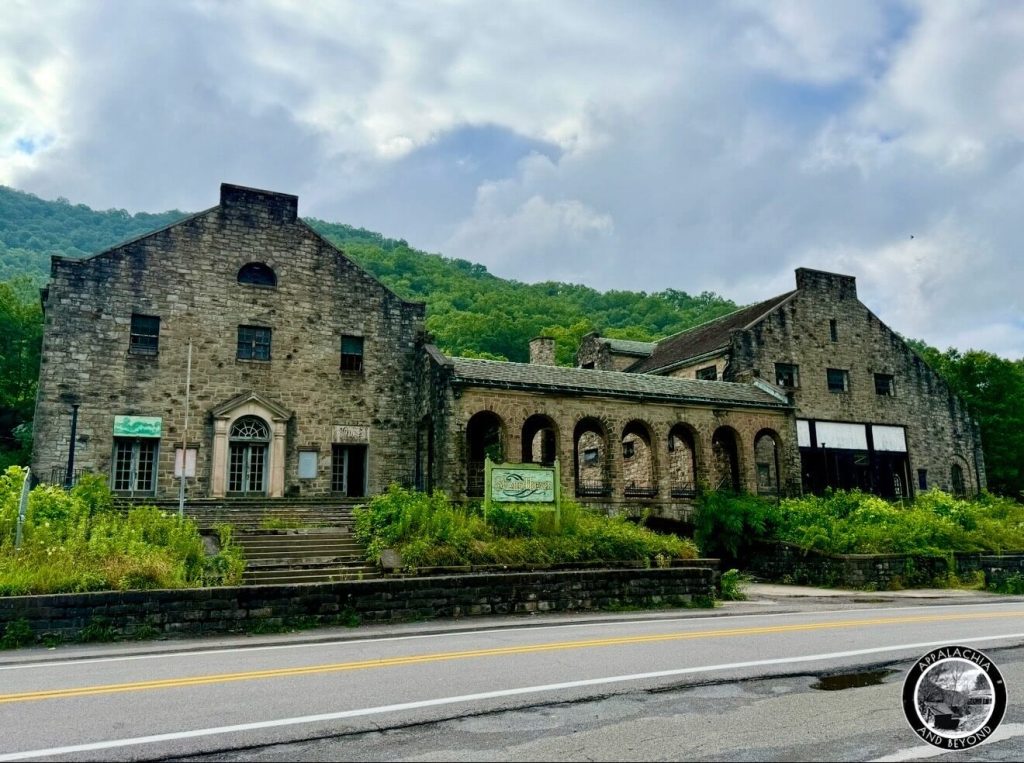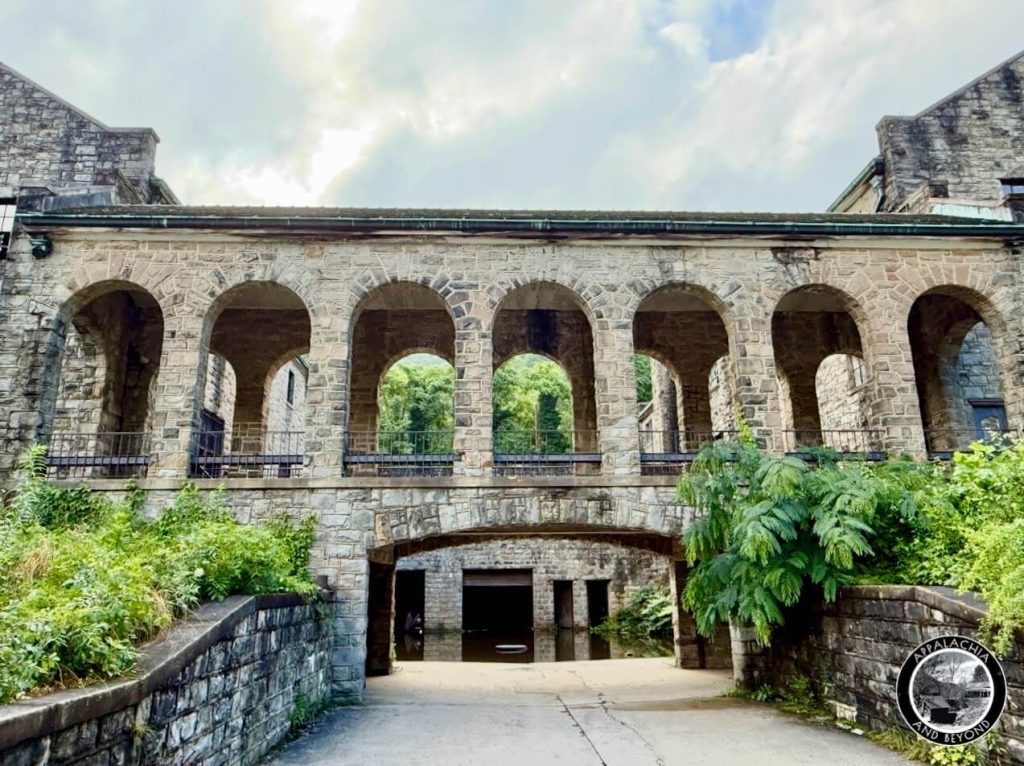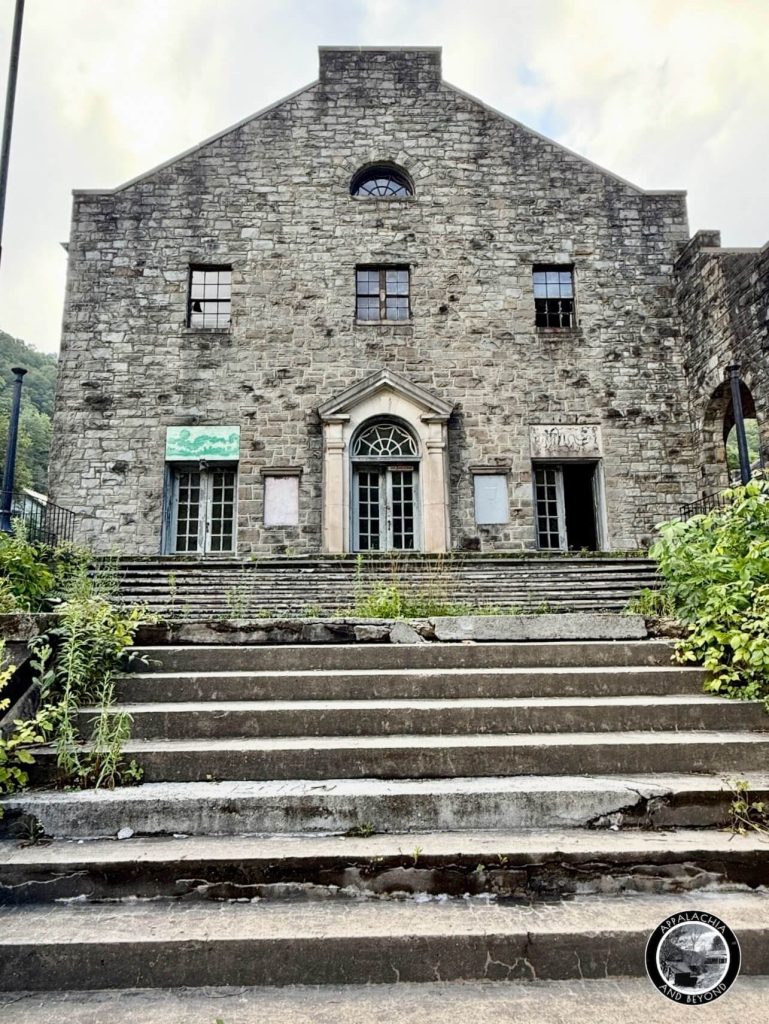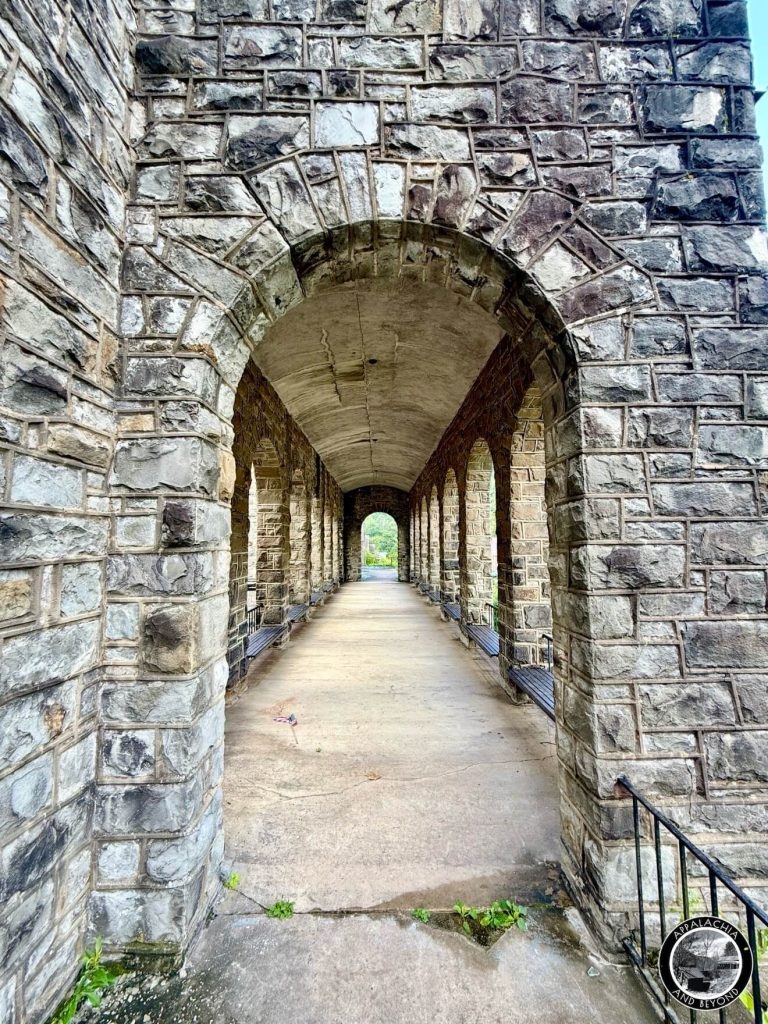Appalachian History Series

A company town takes shape
In 1916 Pocahontas Fuel established a new camp on the Guyandotte and named it for company president Isaac T. Mann. Within a short time Itmann gained pre cut houses, two early frame stores, a theater, and segregated schools. The store site was graded in 1917 in anticipation of a larger, permanent building that would anchor the town.
Itmann’s neighborhoods climbed the hillside behind the store in half concentric rings. Ritter Lumber supplied roughly 120 ready made dwellings, most erected in a rapid three month push during 1918. The pattern placed the company store at the foot of the hill, a literal and social center.
A stone landmark by A. B. Mahood
Between 1923 and 1925, Bluefield architect Alex B. Mahood designed and oversaw construction of a rough faced native sandstone complex that fused Classical Revival symmetry with a coalfield program. Two parapeted gable front wings face the highway and embrace an open courtyard linked by a loggia. Green ceramic tile roofs cap the wings and arcade.
The National Park Service listed the Itmann Company Store and Office on November 28, 1990 for significance in industry and social history under Criterion A and for architecture under Criterion C. The nomination also flags Ethnic Heritage, European.

Building the store
Work crews quarried stone from the cliff across the river, sledged it downhill, and set it by hand. Italian stonemasons provided much of the skilled labor, a reminder that immigration reshaped the coalfields in the early 1900s. The result dwarfed every frame structure around it and remains one of the region’s most imposing company stores.
What happened inside
The building condensed a coal camp’s daily life. It housed retail counters, the company’s general offices, and the post office. Residents depended on the store for food, clothing, furniture, and even caskets. Like other coalfield stores, Itmann’s operation recaptured wages through scrip and prices, and it curated the town’s social space.
More broadly, company stores functioned as commercial and civic hubs across southern West Virginia in the 1910s and 1920s. Most combined retail with payroll, mail, and management, which concentrates power and convenience in a single address.
Boom, pause, and reuse
After an early flourish the nearby Pocahontas operations closed in 1928. The store and post office continued for a time. By 1941 the Wyoming County Department of Public Assistance occupied offices in the building. The complex’s changing tenants tracked the town’s fortunes across the twentieth century.
Postwar investment brought activity back to Itmann. The mine reopened in 1948 and transportation improvements tied the camp more closely to the outside world. Even as the store’s role diminished, the stone landmark remained a central presence.

Itmann in the records
Itmann’s later decades show up in the federal regulatory record. In 1970 the Itmann Coal Company petitioned to modify interim safety standards for the Itmann No. 1 and No. 2 mines, filings that place the camp in the modern compliance era. More recently MSHA records note petitions for the newer Itmann No. 5 Mine.
What the archives hold
Historic photographs document the store’s monumental presence and the work that supported it. West Virginia & Regional History Center holds a period view titled “Store and Office Building, Pocahontas Fuel Company, Inc., Itmann” and a 1953 interior shot of miners at work in an Itmann Coal Company mine.
The Pocahontas Mines Collection at Virginia Tech preserves maps and drawings that put the store and town on paper. The finding aid lists an “Itmann, West Virginia, town map with houses and buildings,” a proposed floor plan for the store from 1949, and numerous Itmann mine plans and plant layouts from the late 1940s through the 1950s.
Researchers on the southern coalfields will also find relevant ledgers, blueprints, and photographs at the Eastern Regional Coal Archives in Bluefield, which maintains accession lists tied to Pocahontas Fuel and the Pocahontas Operators Association.
Kin and comparanda
Mahood and Pocahontas Fuel used similar big shouldered classicism at Jenkinjones in 1917. That company store and the facing office building provide context for Itmann as part of a corporate type. Comparing these designs clarifies how Mahood adapted classical motifs to mining company programs.

Why Itmann matters
State preservation planners use Itmann as the emblem of coalfield store architecture. The building’s materials, plan, and social role make it a key case study for how capital and community were staged in the coal boom. In short, the store is both artifact and archive, a place where architectural form and labor history meet.
On the ground today
A state historical marker in front of the building summarizes the story for passersby. It notes the 1916 founding, the 1923 to 1925 construction by Italian stonemasons, Mahood’s authorship, and the 1990 National Register listing. The Wyoming County NRHP index confirms the listing date and location on WV 10 and 16.
Sources and further reading
National Register of Historic Places nomination: Itmann Company Store and Office (Mary E. Johnson, 1990). Statement of significance, architectural description, and history, with plan and boundary details. PDF via NPS and WV SHPO. NPGallery+2NPGallery+2
West Virginia & Regional History Center, History OnView: “Store and Office Building, Pocahontas Fuel Company, Inc., Itmann, Wyoming County, W. Va.” ID 003083. Period photograph. wvhistoryonview.org
History OnView: “Miners at Work in an Itmann Coal Company Mine,” July 1953, ID 003065. wvhistoryonview.org
Virginia Tech, Pocahontas Mines Collection, Ms2004 002: Finding aid entries for Itmann town map and 1949 Itmann Store proposed floor plan, plus extensive mine and plant drawings. ead.lib.virginia.edu
Eastern Regional Coal Archives, Craft Memorial Library: Repository overview and accession list for coal company records, including Pocahontas Operators Association material. CraftMemorialLibrary+1
Federal Register and MSHA: 1970 petitions by Itmann Coal Co. for Itmann No. 1 and No. 2 mines; recent docketing for Itmann No. 5 Mine. GovInfo+2GovInfo+2
SAH Archipedia: “Itmann Company Store and Office (Former)” and “Houses” entries for Itmann. Architectural analysis, materials, and town plan. SAH ARCHIPEDIA+1
e WV: The West Virginia Encyclopedia: “Itmann Company Store.” Historical synopsis with link to the NRHP nomination. West Virginia Encyclopedia
WV SHPO: Statewide Historic Preservation Plan 2020–2024 uses Itmann as an exemplar of company store architecture. West Virginia Culture Center
WV SHPO County Index: Wyoming County, “Itmann Company Store and Office, SR 10 16 (11 28 90).” West Virginia Culture Center
Historical Marker Database: “Itmann” marker with summary text on the store, architect, and construction dates. Human Molcular Disease Browser
Comparative NRHP: Pocahontas Fuel Company Store and Office Buildings, Jenkinjones (1917, A. B. Mahood). West Virginia Culture Center
Author Note: Itmann sits in the heart of southern West Virginia coal country, so a landmark company store here makes sense. The building’s scale and finish reflect the reach of Pocahontas Fuel and the central role a store and office played in a company town. Many thanks to Appalachia and Beyond for the photographs featured with this piece.